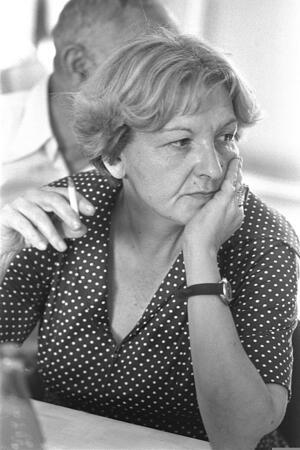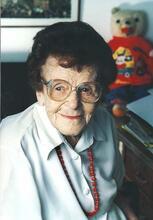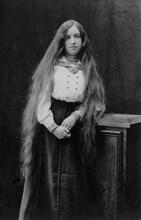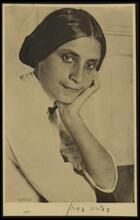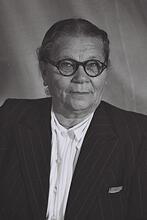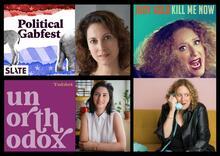Women Journalists in Israel
The entry discusses trends in the employment of women in Israeli journalism. Empirical evidence from several studies demonstrates the feminization process of Israeli journalism. But it also reveals a stubborn resistance to substantive change toward gender equity in the field of journalism. Israeli women are integrated in a variety of roles in newsrooms, seen especially as writers in women's magazines and as news presenters on television. Despite this, they remain excluded from key aspects of the field and their occupational status is unequal to men. Therefore, they advocate and act for change within the profession.
Introduction
Feminist politics assumes that to negotiate and acquire equal rights and civic belonging, people must enter and be active in the public sphere. Given the social power news media have to influence democratic processes, feminist media scholars focus on their crucial role for women seeking fuller social involvement. Indeed, women’s participation in news-making has always been perceived as a manifestation of women’s equality. Therefore, the failure of women to achieve jobs of high visibility and status in news media organizations has been seen as symptomatic of fundamental problems of gendered inequality (Byerly and Padovani, 2017). In practical terms, since the media are increasingly powerful in shaping public opinion and culture, access to news media production is a key concern of feminist scholars and activists.
In this entry, we focus on the historical, occupational, and cultural aspects of the participation of women in Israeli journalism before the founding of Israel and in the early decades of the State. We then discuss quantitative and qualitative aspects of women’s participation in the profession and present the obstacles women journalists in Israel currently confront and their efforts for social change toward a more gender-equal profession. To better understand the state of Israeli women journalists, we will first undertake a short review of the attributes of the Israeli news media and its historical roots.
The Landscape of Israeli News Media
Israeli media scholars point to a three-phase development of the news media in Israel. The first, which began in the pre-state Jewish community in Palestine and lasted through the first decades of the State of Israel, was characterized by party-owned newspapers and advocacy journalism (Markowitz-Elfassi et al., 2021). During this phase, newspapers contributed to building the nation and creating a distinctive Hebrew identity (Soffer, 2011). The second phase, starting about 1970, saw the emergence of professional and adversarial journalists. The media developed into a system controlled by privately owned and commercially oriented newspapers on the one hand, and public radio and television broadcasting supervised by political authorities on the other hand. In the third phase, which began in the 1990s, the Israeli media became more like modern Western media systems. An "open skies" policy led to the establishment of commercial, cable, and satellite television stations and regional radio stations. This was followed by dramatic changes in the print media and the creation of online news media. The new electronic and digital media are controlled by private franchises and operated under commercial logic, but they were regulated by state authorities (Markowitz-Elfassi et al., 2021).
As in other countries, the Israeli media market of the third phase has seen massive cross-ownership and conglomeration that weaken the power of individual journalists (Caspi, 2012). The dominance of the commercial-capitalist media model has also caused a sharp decline in the number of unionized journalists. The collapse of organized labor eliminated the possibility of journalistic tenure, making it much easier for employers to lay off journalists. This, in turn, increased the rapid turnover in the profession and made journalists more vulnerable to internal and external pressures (Avrahamy, 2005). Rather than being based on merit, recruitment procedures for Israeli journalism were based on social ties and networks or personal acquaintance with decision-makers. Moreover, the profession lacked official criteria to assess staff or promote workers. In the absence of specialized training or professional schools, people became experts in the field through on-the-job experience (Caspi and Limor, 1999). Feminist media scholars have documented over the years how such organizational procedures exclude women as potential applicants and at the same time make it more difficult for women to contest this situation (e.g., van Zoonen, 1994).
Additionally, the dominant media coverage of national security and the ongoing cycle of violent conflicts has shaped many aspects of Israeli public life and journalistic discourse that are not directly related to the conflicts (Tsfati and Meyers, 2012). The public discourse, which prioritizes military and war issues, legitimizes marginalizing women in Israeli society and excludes them from the main political arena (Herzog, 2006). Although some women have penetrated the male fortress of covering security and army topics (Lemish, 2007), these issues are still mainly men's territory.
Women Writers in Pre-State Hebrew Journalism
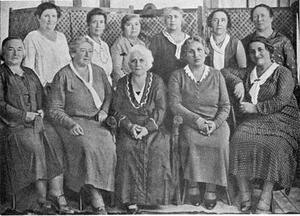
Courtesy of Ha-Keren le-Ezrat ha-Isha.
In the early years of the Hebrew press in pre-State Palestine in the mid-nineteenth- century, newspapers and magazines were written by and for men. Women’s absence in the profession stemmed in part from the fact that, following customs in Europe, they were not taught Hebrew and received little formal education. This lack of education often led to low self-confidence, further decreasing the possibility women would write for the public. Only in the early 1920s, when the press sought to reach a female audience, were women allowed to enter the field (Govrin, 2000).
The few women who did write were mainly daughters of educated families influenced by the Haskalah movement. Encouraged by their parents, they learned Hebrew and showed strong will and independence of mind. Moreover, they shared what Govrin defines as "feminine consciousness and were motivated by the need to compete with men and prove that they were capable, for they were received coldly by the critics and society at large" (p. 5e).
The first woman to write for a Hebrew periodical was Rachel Morpurgo (1799-1871), an Italian Hebrew poet. Other known writers who worked in pre-state Palestine in the first half of the twentieth century were Nehamah Feinstein Pokhachewsky (1869-1934), Hemdah Ben-Yehuda (1873-1951), and Devorah Baron (1887-1956). However, these women writers were the exceptions. In this period, even the press targeting children and youth was dominated by men.
Feminization and Segregation in Israeli News Media
During the first three decades after the State of Israel was created in 1948, the field of journalism—print and broadcast journalism—continued to be dominated by men. During the 1960s, for example, only 7% of journalists employed by daily newspapers were women (Caspi and Limor, 1999). However, in the mid-1970s and into the 1980s, women began to enter this previously all-male domain. The share of women working in journalism reached 37% in 1996 (Caspi and Limor, 1999). This development was part of the more general trend of women’s entry into the Israeli labor market after the October 1973 War, which resulted in the feminization of other professions as well. However, this proportion was lower than the proportion of women in the general working population (44% in 1998) (Central Bureau of Statistics, 1998). The gender shift in journalism employment also occurred alongside the accelerated expansion of the news industry in Israel and the decline in the job’s professional status, which resulted in declining salaries and benefits. This decline decreased the attractiveness of the field to men in Israel, a trend that occurred in other countries as well.
In the late 1990s, the share of women working in journalism plateaued, with women still a minority in the profession (Lachover and Lemish, 2018). According to a few recent surveys carried out in Israel as part of international studies, the overall share of female reporters, announcers, and presenters varies between 35% and 42% (GMMP 2015, 2020). One explanation for the slowdown is the more general constriction in the profession, which has meant that journalism no longer has a shortage of workers. Given that the desire to employ women in previous decades was due to their unique gender skills and tendencies, there was now less pressure to employ them. The deceleration in women’s employment in journalism seems to be a happening globally: the 2015 Global Media Monitoring Project (GMMP) data suggest that while the proportion of women journalists grew between 1995 and 2005, this expansion later stopped. However, the global 2020 GMMP does indicate that since 2015, the presence of women journalists in the profession has increased by three percentage points worldwide.
Alongside the entrance of women into the field of Israeli journalism, another process took place that has elicited less attention: horizontal and vertical internal gender segregation. Women in Israel's newsrooms are still at an organizational and professional disadvantage compared with their male counterparts. They mainly cover “soft” issues, such as consumerism and lifestyle issues, and they report on politics, crime, and violence less often than their male counterparts do. Moreover, while women journalists are fairly well distributed across the occupational levels of Israeli news companies, they have relatively little decision-making power inside Israeli news companies (women comprise around only one-fourth of senior management, and around one-third of those in middle management (Lachover, 2013). They also tend to occupy part-time positions more often than men do, as is the case in other professions (Lachover and Lemish, 2018).
In 1974, women achieved a new level of leadership in print journalism when three women served as editors-in-chief of Israeli dailies. One of these pioneering women was Hannah Zemer (1925-2003), who broke through the gendered boundaries of the journalism profession in a way no other Israeli woman had done before or since. She served as editor-in-chief of Davar, an important daily of Labor politics, for two decades. Viewed retrospectively, however, this female leadership in 1974 did not mark a turning point in the status of women in the press. As of 2022, no other woman had been named editor-in-chief of a major news organization.
One of the most prominent obstacles facing women journalists in Israel is the need to balance work and family commitments, given the shortening of news cycles and the increased demand for around-the-clock media presence. Israel’s situation is particularly complicated because of the country’s high valuing of the institution of the family and its high birth rate compared to other democracies. In most parts of the world, female journalists are less likely than male journalists to be married and have children (Steiner, 2014). However, in Israel, women in journalism typically have the same-sized families as their male colleagues (likely a result of internalizing the Israeli sanctification of the family), but at the same time, they face unequal division of labor in the domestic sphere (Lachover and Lemish, 2018).
Online news in Israel has gradually become the central source of news information. In a survey of the Central Bureau of Statistics from 2020, 38% of Israelis (aged above 20) reported using online news as their primary source of news (Israel Internet Association, 2020). Feminist media scholars predicted that digital journalism would create new opportunities and forms of journalism for women’s participation. While in the past women left full-time journalism and worked from home as freelancers, now they could write and edit from remote locations and advance branding through social media (e.g., Franks, 2013). However, the transition to digital journalism has surprisingly not fully opened new opportunities for Israeli women journalists. The 2020 Global Media Monitoring Project study indicated that Israeli women reporters still lag in representation in internet news (24%) and on Twitter (43%). One potential explanation is that the online news industry in Israel is still in early phases of development, with men being the first to integrate within it. In such a scenario, more women will find employment there over time.
Israeli Women as Television News Presenters
A notable trend in the media over the years—in Israel and globally—is the greater presence of women as television news presenters relative to their roles as news reporters. This trend is explained by the more general focus on women’s appearance in society, which is particularly salient when they appear on the screen. This objectification of women is reinforced by age-related bias: women presenters in Israeli media are younger than male colleagues and are held to stricter expectations of attractive appearance. This high visibility of news presenters on television, the dominant medium in the Israeli news sphere, could contribute to the common misperception that the news world is dominated by women. The field also clearly distinguishes between news presenters (delivering news created by others) and news reporters and commentators (who voice their own journalistic work and commentary).
Moreover, despite female news readers’ accumulated years of experience, they cease to be assigned the presenter’s role as they age and are presumed to be less attractive. This was the case at the end of the 1990s for such prominent presenters as Carmit Guy, Sari Raz, and Dalya Mazor. By contrast, leading male presenters remain on the screen, supposedly gaining experience and authority as they age. One example is Haim Yavin, “Mr. Television,” who served as anchor on Israeli public television’s leading news program, “Mabat La’Hadashot” (“A View to the News”), from the establishment of Israeli television in 1968 until he retired in 2008 at the age of 76. This discrepancy highlights the prevailing sexist attitudes establishing what is considered of value for both genders.
Women’s more prominent role as news presenters also stems from the stereotype of women as warm, caring, and trustworthy. For example, in 1993 when Shalom Kital, Executive Director of Channel 2 news, hired Miki Haimovich to present the main national television broadcasting of the news company, he said in an interview: “When we put on Miki’s tape, we had to admit, we just knew she was it. I understand that television is also an emotional medium” (Tik Tikshoret, 2010).
Periods of crisis in Israel expose further stereotypical gendered attitudes toward women presenters. Dafna Lemish and Chava Tidhar (1999) provide an Israeli example of this in their case study of television presenter Orly Yaniv during the Gulf War of 1990-1991. In interviews, Broadcasting Authority decision-makers rationalized the exclusion of women from broadcast news during the war as being due to the public’s need for authoritative figures during a time of crisis. In their view, Orly Yaniv was a uniquely “soft” personality, “compassionate” and “motherly.” Therefore, she was only “allowed” to present news in an alternative format (e.g., conducting human interest interviews, while receiving live instructions from the director in the control room on substantive issues).
Women Journalists in Women's Magazines
The separation between general and "feminine" press prevailed during Israel’s pre-state period, seen in women's sections and in separate women’s publications. Regular women's columns in the Hebrew daily press began to appear in the 1930s in the style of similar columns in the European press, focusing on advice and guidance relating to domestic matters. During the 1940s and 1950s, these columns also dealt with issues of legislation, women's organizations, women's equality, and women's welfare. This separation manifested the distinction between the general public news domain, identified with the masculine world, and the private domain, identified with the feminine world (Herzog, 2000).
The women's sections, usually published once a week, were led by women editors who worked under the editor-in-chief, always a man. In the 1950s, Miriam Shir wrote the Davar women's page, and Shulamit Levari and Aliza Holdheim wrote the women's section in Haaretz (Geva, 2019).
Preceding commercial women’s magazines, ideological women’s magazines associated with political parties or movements represented in the Israeli parliament have been published since the 1920s. The earliest of these was Ha'isha (The Woman) (1926-1929), a monthly published by the Histadrut Nashim Ivriot (Federation of Hebrew Women in Eretz Yisrael) and edited by Hannah Helena Thon (Keren, 2000). Another monthly, Bat Yisrael Ve'eretz Yosrael (Daughter of Israel and the Land of Israel), later renamed Bat Ami (Daughter of My People), came out in Yiddish and was published by the Jewish National Fund from 1930 to 1940 (Herzog, 2000). Davar's Dvar Hapo'elet (identified with the Labor Movement) was first published in 1934 and is still published today under the title Bit'on Na'amat (The Organ of Na'amat, the Women's Workers' Movement). The founding editor was Rahel Katzenelson (Eldar, 2020).
Commercial women's magazines have been published since the mid-twentieth century. The first was Olam Ha'isha (Woman's World), published from 1940 to 1948. La’isha (For the Woman), the most popular and longest running privately owned commercial women’s magazine in the country, came into being in 1947. Founded by the daily paper Yedioth Aharonoth, it immediately became very popular (Rubin, 1987). Ha’isha Bamedinah (The Woman in the State; 1949-1953) was edited by Tehila Matmon (Geva, 2019). At (You in the feminine form) came out in 1967 and became Laisha's competitor. Others, like Nashim (Women; 1997-) and Pnima (Inward; 2011-) are directed at religious women. Although Israeli commercial women's magazines function as a platform for airing feminist issues, they are primarily economic projects designed to attract as broad a readership as possible and to focus on "feel-good" contextual content (Herzog, 2000). Like most Israeli print journalism, women's magazines have seen a drop in readership as a result of the growing popularity of digital women’s magazines. Still, La’isha is the most popular women’s print magazine in Israel, and is moreover the most widely circulated magazine of any type in the country (Lachover, 2019). In September 2021, At moved to a digital version only.
Unfortunately, no data exist that might provide insight into the characteristics of the editorship of commercial women’s magazines. However, similar to Western women’s magazines, during the 1960s and 1970s the editors of La’isha and At were men, whereas even then most of the writers were women (Lachover, 2019).
Israeli Women Journalists’ Activism
While effective activism by women in news organizations in the United States was already seen in the 1970s (Byerly and Ross 2006), female journalists in Israel did not organize to fight for employment rights and status until 2011. In that year, a group of women journalists came together to promote their rights and founded the Women Journalists Chamber. Since its establishment, the Women Journalists Chamber has worked to improve the employment conditions of Israeli women journalists and bring about more equal representation in the media. In the public sphere, the organization is known primarily for its activities around sexual harassment. Soon after its founding, the group exposed dozens of reports of misconduct by senior media figures, placing the issue of sexual harassment in news organizations on the public agenda for the first time.
Moreover, Israel, like elsewhere in the world, was affected almost immediately by the #MeToo movement. Early-stage discourse in the Israeli media focused on the testimonies of veteran women journalists speaking of their past harassment by senior figures in the industry. The wave of testimonies by women journalists in Israel indicates their feminist coming of age. If in the past women journalists hesitated to define the humiliation they suffered as sexual harassment (Lachover, 2005), today many well-known women in the industry are taking a bold personal and political stand—despite risks such as the threat of being sued for slander. These women are inspiring their younger colleagues, who lack the same employment security; they, too, are joining the protests, often anonymously.
Avrahamy, Eyal. Guarding shift. The seventh eye, 1 July 2005. https://www.the7eye.org.il/28493
Byerly, Carolyn M. and Claudia Padovani. Research and policy review. In Gender and equality and the media: A challenge for Europe, edited by Karen Ross and Claudia Padovani, 7–29. London: Routledge, 2017.
Byerly, Carolyn M. and Karen Ross. Women and media: A critical introduction. Malden, MA: Blackwell, 2006.
Caspi, Dan. Beyond the mirror: The Israeli media map. Beer Sheba: Bialik Publishing. 2012. [Hebrew]
Caspi, Dan and Yehiel Limor. The in/outsider: Mass media in Israel. Cresskill, NJ: Hampton Press, 1999.
Central Bureau of Statistics. Women and men: Data collection. Jerusalem: CBS, 2000.
Eldar, Eran. Dva Ha'poelet: History of a female workers newspaper, Kesher 54 (2020): 117-145. [Hebrew].
Franks, Suzanne. Women and journalism, Oxford: Oxford University Press, 2013.
Geva, Sharon. Ahead of its time: Ha'ishah Bamedinah – The story of a forgotten women's journal in Israel. Nashim: A Journal of Jewish Women's Studies & Gender Issues 34 (2019): 98–122.
Global Media Monitoring Project 2015. Who Makes the News? World Association for Christian Communication (WACC), 2015. https://www.media-diversity.org/additional-files/Who_Makes_the_News_-_Global_Media_Monitoring_Project.pdf.
Global Media Monitoring Project 2020. Who Makes the News? World Association for Christian Communication (WACC), 2020. https://whomakesthenews.org/wp-content/uploads/2021/07/GMMP2020.ENG_.FINAL20210713.pdf
Govrin, Nurit. Women in the Hebrew press: Beginnings. Qesher 28 (2000): 12–14. [Hebrew with English abstract].
Herzog, Hannah. The women’s press in Israel: An arena for reproduction or for challenge? Kesher 28 (2000): 43–52.
Herzog, Hannah. Between the lawn and the gravel path – women, politics and civil society. Democratic Culture. Gender and Society in Israel 10 (2006): 191–214. [Hebrew].
Israel Internet Association. Digital new consumption – The social survey for 2020. https://www.isoc.org.il/sts-data/internet-news-consumption-social-survey-2020
Lachover, Einat. The gendered and sexualized relationship between Israeli women journalists and their male news sources. Journalism 6, no. 3 (2005): 265–90.
Lachover, Einat. Israel: Women still a minority, but in a better place. In The Palgrave international handbook on women and journalism, edited by Carolyn M. Byerly, 122–136. New York: Palgrave Macmillan, 2013.
Lachover, Einat. The political and civic potential of popular women's magazines: The Israeli case. International Journal of Communication, 13 (2019): 3403–3421. https://api.semanticscholar.org/CorpusID:201360379
Lachover, Einat and Dafna Lemish. "Women in Israeli journalism: Forwards and backwards." Israel Affairs 28, no. 3 (2018): 500–518.
Lemish, Dafna. The politics of exclusion: Representations of women and violence against them. In Communication and politics in Israel, edited by Dan Caspi, 185–207. Jerusalem: Van Leer Jerusalem Institute, 2007. [Hebrew]
Lemish, Dafna, and Chava E. Tidhar. Where have all the young girls gone? The Disappearance of Israeli women-broadcasters during the Gulf War." Women and Language 14, no. 1 (1999): 13-21.
Markowitz-Elfassi, Dana, Tamir Sheaffer, Yariv Tsfati, Gabriel Weimann, and Gadi Wolfsfeld. Political communication and Israeli politics. In The Oxford handbook of Israeli politics and society. Edited by Reuven Y. Hazan, Alan Dowty, Menachem Hof nung and Gideon Rahat, 637-651. Oxford: Oxford University Press, 2021.
Soffer, Oren. Mass communication in Israel: Nationalism, globalization, and segmentation. New York and Oxford: Berghahn, 2011.
Steiner, Linda. Glassy architectures in journalism. In The Routledge companion to media and gender, edited by Cynthia Carter, Linda Steiner, and Lisa McLaughlin, 620–32. London: Routledge, 2014.
Tik Tikshoret. "The anchor." Tik Tikshoret. Last modified 24 December 2010. http://www.the7eye.org.il/40807.
Tsfati, Yariv and Oren Meyers. “Journalists in Israel.: In The global journalist in the 21st century, edited by D. H. Weaver and L. Willnat, 443–57. New York, NY: Routledge, 2012.
Van Zoonen, Liesbeth. Feminist media studies. London: Sage, 1994.

